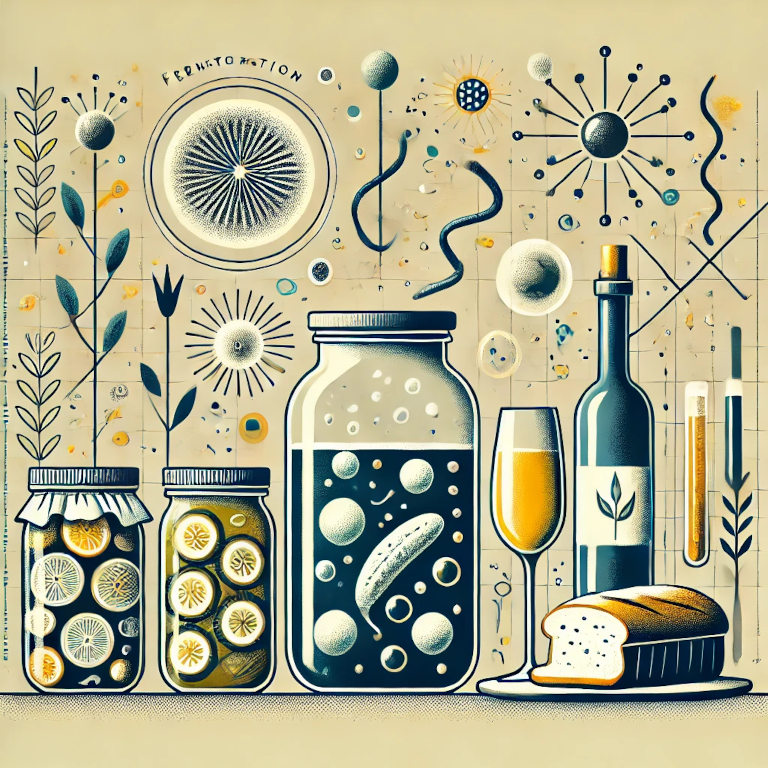Fermentation is an age-old technique that has been used for centuries to preserve food, enhance flavors, and promote health. As an expert in Food and Cooking, this article will delve into the fascinating world of fermentation, exploring its processes, benefits, and practical applications.
Understanding Fermentation
Fermentation is a metabolic process that converts carbohydrates, such as sugars and starches, into alcohol or acids using microorganisms like bacteria, yeast, or fungi. This process not only preserves food but also enhances its nutritional value and flavor. There are several types of fermentation, including lactic acid fermentation, alcohol fermentation, and acetic acid fermentation.
Types of Fermentation
1. Lactic Acid Fermentation
Lactic acid fermentation is carried out by lactic acid bacteria, which convert sugars into lactic acid. This type of fermentation is commonly used in the production of yogurt, sauerkraut, kimchi, and pickles.
- Yogurt: Milk is inoculated with beneficial bacteria such as Lactobacillus bulgaricus and Streptococcus thermophilus, which ferment the lactose in milk into lactic acid, giving yogurt its tangy flavor and thick texture.
- Sauerkraut and Kimchi: Cabbage and other vegetables are mixed with salt and left to ferment, creating tangy, flavorful dishes rich in probiotics.
2. Alcohol Fermentation
Alcohol fermentation is performed by yeast, which converts sugars into alcohol and carbon dioxide. This type of fermentation is used in the production of alcoholic beverages such as beer, wine, and spirits, as well as in baking.
- Beer and Wine: Yeast ferments the sugars in grains or fruits, producing alcohol and carbon dioxide. The specific strains of yeast and fermentation conditions affect the flavor and characteristics of the final product.
- Bread: Yeast ferments the sugars in dough, producing carbon dioxide, which causes the dough to rise and gives bread its airy texture.
3. Acetic Acid Fermentation
Acetic acid fermentation involves the conversion of alcohol into acetic acid by acetic acid bacteria. This type of fermentation is used to produce vinegar.
- Vinegar: Alcoholic liquids such as wine, cider, or beer are exposed to oxygen and acetic acid bacteria, which convert the alcohol into acetic acid, resulting in vinegar.
Benefits of Fermentation
1. Preservation
Fermentation extends the shelf life of perishable foods by creating an environment that inhibits the growth of harmful bacteria. The acids and alcohols produced during fermentation act as natural preservatives.
2. Enhanced Nutritional Value
Fermentation can increase the nutritional value of food by producing vitamins, enzymes, and beneficial bacteria. Fermented foods are rich in probiotics, which promote gut health and improve digestion.
3. Improved Flavor and Texture
Fermentation enhances the flavor and texture of foods, creating complex, tangy, and savory profiles. The process can also break down tough fibers, making foods more tender and palatable.
Practical Applications of Fermentation
1. Making Fermented Vegetables
Fermenting vegetables is a simple and rewarding way to incorporate probiotics into your diet. Here’s a basic guide to making fermented vegetables:
- Ingredients: Fresh vegetables (such as cabbage, carrots, or cucumbers), non-iodized salt, and filtered water.
- Preparation: Wash and chop the vegetables. Dissolve salt in water to create a brine.
- Fermentation: Pack the vegetables tightly into a clean jar, pour the brine over them, and ensure they are fully submerged. Cover the jar with a lid or cloth and let it sit at room temperature for several days to weeks, depending on your taste preference. Check the vegetables regularly and press them down if they float above the brine.
- Storage: Once the vegetables are fermented to your liking, store the jar in the refrigerator to slow the fermentation process.
2. Making Yogurt at Home
Homemade yogurt is delicious and easy to make. Here’s a simple method:
- Ingredients: Milk and a yogurt starter culture (plain yogurt with live active cultures).
- Preparation: Heat the milk to around 180°F (82°C) to kill any unwanted bacteria, then let it cool to 110°F (43°C).
- Inoculation: Stir in the yogurt starter culture.
- Incubation: Pour the mixture into a clean container, cover it, and keep it warm (around 110°F) for 6-12 hours until it thickens.
- Storage: Refrigerate the yogurt and enjoy it plain or with your favorite toppings.
Summary
Fermentation is a versatile and beneficial technique in food and cooking, offering a wealth of advantages from preservation to enhanced flavor and nutrition. By understanding the different types of fermentation and their applications, you can incorporate this ancient practice into your culinary repertoire. Whether you’re making fermented vegetables, yogurt, or sourdough bread, the art of fermentation opens up a world of possibilities for creating delicious, healthy foods.






